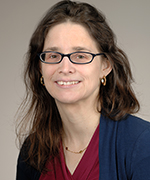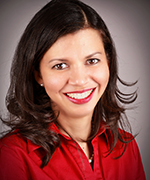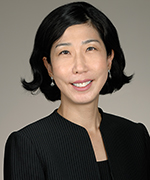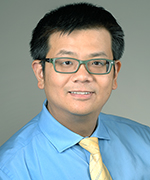Lasker Clinical Research Scholars
Compassionate Physicians with an Eye for Research
BY LAURA STEPHENSON CARTER
Congratulations to the four newest NIH Lasker Clinical Research Scholars: cancer researchers Christine Alewine, Jung-Min Lee, and Frank Lin, and sickle-cell disease researcher Courtney Fitzhugh. They join 10 others in the Lasker program.
Christine Alewine (National Cancer Institute, NCI) is conducting clinical trials to test the effectiveness of a recombinant immunotoxin in combination with standard-of-care chemotherapy in patients who have advanced pancreatic cancer.
Jung-Min Lee (NCI) is conducting clinical and translational research to study the clinical activity and biomarkers of new immune-based DNA injury combination therapies in women who have recurrent ovarian cancer.
Frank Lin (NCI) is using targeted radionuclide therapy (tRNT) to treat cancer. Unlike conventional external-beam radiation therapy, tRNT is able to target and treat cancer cells throughout the entire body and has the potential to deliver lethal radiation doses to even micro-metastases.
Courtney Fitzhugh (National Heart, Lung, and Blood Institute) is seeking to improve—and develop new—treatment options to achieve a cure for sickle-cell disease.
In 2010, NIH announced the Lasker Clinical Research Scholars Program, an “intramural–extramural” NIH program in partnership with the Albert and Mary Lasker Foundation. It funds a few exceptional clinical researchers in the early stages of their careers. In the current program, the scholars can work as principal investigators at NIH for five to seven years and then can either remain on the intramural tenure track or move—with three years of research funding—to a university or other research institution. The Lasker Foundation provides the opportunity for the scholars to attend its annual awards luncheon, where they can present their results and interact with senior colleagues. To learn more about the program and current Lasker Clinical Research Scholars, go to https://www.nih.gov/research-training/lasker-clinical-research-scholars.
The following is a lightly edited version of interviews with Alewine, Fitzhugh, Lee, and Lin.
CHRISTINE CAMPO ALEWINE, M.D., PH.D.
Lasker Clinical Research Scholar, Laboratory of Molecular Biology, Center for Cancer Research, National Cancer Institute

Education: Dartmouth College, Hanover, N.H. (B.A. in chemistry and Asian studies); University of Maryland School of Medicine, Baltimore (Ph.D. in physiology; M.D.)
Training: Residency in internal medicine at Johns Hopkins Hospital (Baltimore); clinical fellow in medical oncology at NCI’s Laboratory of Molecular Biology
Came to NIH: In 1998–1999 as postbac, Cancer Research Training Award Fellow, NCI’s Laboratory of Pathology; in 2011–2014 as a clinical fellow; became an assistant clinical investigator in 2014
Outside interests: Tennis; hiking; quilting; Girl Scout troop leader; spending time with her husband and their two daughters
Website: https://irp.nih.gov/pi/christine-alewine
Current research: My work focuses on developing treatments for pancreatic cancer, a devastating disease that kills more than 40,000 Americans each year. Just nine percent of patients survive five years or more after diagnosis because the disease metastasizes very early in its development and is resistant to most current treatments. More effective systemic therapies are needed for our patients.
I am studying recombinant immunotoxins, which are antibody-based anticancer therapeutics that deliver a very potent bacterial toxin specifically to cancer cells. The bacterial toxin halts protein synthesis in the cancer cell. SS1P and LMB-100 are two recombinant immunotoxins that we are testing in the clinic for patients with solid tumors, including pancreatic cancer. These immunotoxins target mesothelin, a protein that is expressed on the surface of almost all pancreatic cancers but has very limited expression in normal tissues. These immunotoxins bind to mesothelin on the cancer-cell surface, the cancer cell internalizes the toxin, and the tumor cells die.
In our clinical trial (NCT02810418) we are testing the safety and tolerability of recombinant immunotoxin LMB-100 in combination with standard-of-care chemotherapy in patients who have advanced pancreatic cancer. Our long-term goal is to develop effective treatment options for these patients. (https://clinicaltrials.gov/ct2/show/NCT02810418?term=16C-0128&rank=1). In mice, the combination makes the tumor go away.
What’s the public-health relevance of your research? Our study may lead to advances in our understanding of whether immunotoxins can be used to treat pancreatic cancer and provide insight into technical aspects of this therapeutic strategy.
How did you become interested in science? I have always wanted to be a scientist. As a kid, I was interested in dinosaurs and stars. Once I got to college, I fell in love with chemistry.
What about medicine? When I was at Dartmouth, one of my hallmates in the dorm almost died of meningococcal meningitis. I remember the people in the white bunny suits (likely from the Centers for Disease Control and Prevention) roaming the halls and cleaning up the dorm. I was struck by how serious the illness was and I wanted to do something that mattered—to help people who were very sick.
What made you decide to get an M.D.-Ph.D.? During college, I was lucky enough to get an internship in the Chemistry Department with Karen Wetterhahn, a chemistry professor who specialized in understanding the environmental effects of toxic metals. One of the more senior students in Karen’s lab was applying to M.D.-Ph.D. programs. I had never heard of this track before but it sounded like it would allow me to combine my interests in basic science and clinical medicine.
What got you interested in cancer research and pancreatic cancer in particular? I can’t really name a particular reason why I have always been so fascinated by cancer. From the time I decided to go to medical school, I knew that I wanted to be an oncologist. Through all my years of training, I never found any subject more interesting: How do your very own cells go bad and turn cancerous? I wanted to understand why that happens and do something about it. Pancreatic cancer is a terrible disease with its very own nasty personality. There are many very unique aspects about this particular tumor type. Unfortunately, although we are learning more and more about the biology of pancreatic tumors all the time, we still don’t have effective drugs to treat our patients with this disease.
What attracted you to NIH? There are very few places today where one can take what one works on in the lab and bring it to patients and back with the ease that we can at NIH. It’s a fantastic opportunity. There is so much protected time to get a lab started and at the same time be able to do clinical trials.
What have you learned so far? That developing drugs is hard work. It takes so much time before you know what’s going on. You have to find something that works, is stable and properly metabolized, and doesn’t kill people. It’s a really difficult problem.
What’s the hardest part of your job? I hate telling patients who want more treatment that I have nothing else that I can offer them.
COURTNEY DAYLE FITZHUGH, M.D.
Lasker Clinical Research Scholar, Sickle Cell Branch, National Heart, Lung, and Blood Institute

Education: University of California, Los Angeles (B.S. in biology); University of California, San Francisco, School of Medicine (M.D.)
Training: Combined residency in internal medicine and pediatrics, Duke University Medical Center (Durham, N.C.); combined fellowship in adult hematology and pediatric hematology/oncology, NIH and Johns Hopkins Hospital (Baltimore)
Came to NIH: In 1999–2000 as a Clinical Research Training Program fellow in NHLBI; in 2005–2007 for clinical fellowship training; in 2007 for research fellowship training in NHLBI’s Molecular and Clinical Hematology Branch; in 2012 became an assistant clinical investigator in the Laboratory of Early Sickle Mortality Prevention, Sickle Cell Branch, NHLBI
Outside interests: Cooking; traveling; playing board games; watching movies
Website: https://www.nhlbi.nih.gov/research/intramural/researchers/pi/fitzhugh-courtney
Current research: Sickle-cell disease (SCD) is associated with debilitating complications including stroke, intense pain, and kidney failure, as well as early mortality. Although matched-sibling bone-marrow transplantation offers the best treatment for people with SCD, only 15 to 20 percent of these patients have a complete sibling match. But more than 90 percent have at least a half-match such as a parent, child, or half-matched siblings. We are developing an alternative option that involves such haploidentical donors.
Our lab employs a regimen that focuses on creating a tolerant state for donor and recipient cells in order to achieve stable mixed chimerism. We are trying to deplete donor and recipient lymphocytes and allow them to grow under the cover of immunosuppressive drugs that will promote tolerance. We are attempting to identify biomarkers that are associated with early graft rejection and evaluating whether prompt treatment leads to prevention or reversal of graft rejection. In addition, we are exploring whether biomarkers associated with transplant tolerance can indicate whether immunosuppressive drugs can be withdrawn. We hope our work will result in a wide range of treatment options for patients with SCD.
What is the public-health relevance of your research? My goal is to develop a widely available, successful half-matched transplant regimen. We are working to optimize tolerance so that the donor and recipient cells coexist, identify and treat graft rejection at a reversible stage, and discontinue immunosuppression in patients who have achieved donor tolerance.
How did you get interested in medicine and sickle-cell disease? My dad is a family-practice physician, and ever since I was a little girl, I have wanted to be a doctor, too. I was in college when I first became interested in SCD: My mom had organized a holiday party at a children’s hospital for children with the disease; I went and enjoyed talking with the patients and painting their faces (in a face-painting activity).
What about sickle-cell disease research appeals to you? Because SCD is a chronic illness, I can take care of children and adults. SCD affects every organ system and can cause pain and even a stroke. I see extremely sick people whom no one else will transplant. Many are on dialysis, have elevated pressure in their lungs, or have heart failure. I feel that I can really make a difference. I want to keep people from dying early.
How did you become interested in NIH? When I was in medical school, I came to NIH as a Clinical Research Training Program fellow and worked with John Tisdale (NHLBI). We used the immunosuppressant drug rapamycin to induce tolerance for bone-marrow transplants performed on normal mice and sickle-cell mice. I did the transplants on the mice, saw patients with SCD in clinic, and wrote a protocol for patients with SCD. I just loved it.
What’s hot in your field right now? Gene therapy and gene editing for SCD. John Tisdale’s group is working on that—taking the patient’s own cells, inserting the normal gene, and attempting to correct the sickle mutation directly.
Is there anything else you’d like to tell us? It’s amazing to see how the lives of patients with SCD are transformed. They had never been able to predict when debilitating painful crises would come. Now, with successful treatment, they can actually make plans and live normal lives.
JUNG-MIN LEE, M.D., NCI-CCR
Lasker Clinical Research Scholar, Women’s Malignancies Branch, Center for Cancer Research, National Cancer Institute

Education: Yonsei University Wonju College of Medicine in Wonju City, South Korea (M.D.)
Training: Residency in internal medicine, Holy Family Hospital, Catholic University Medical College (Seoul, South Korea); research fellowship in pathology and cell biology at Thomas Jefferson University (Philadelphia); residency in internal medicine at the Albert Einstein Medical College (New York); clinical research fellowship on breast-cancer functional imaging at the Memorial Sloan-Kettering Cancer Center (New York); medical oncology/hematology fellow in NCI’s Medical Oncology Branch
Came to NIH: In 2008–2012 for training; in 2012 became an assistant clinical investigator in NCI
Outside interests: Going to museums; traveling; swimming; meditating
Website: https://ccr.cancer.gov/Womens-Malignancies-Branch/jung-min-lee
Current research: My research is focused on cancers that share similar molecular abnormalities: BRCA mutation-associated breast or ovarian cancer, high-grade epithelial ovarian cancer, and triple negative breast cancer (TNBC). I am the principal investigator for ongoing phase 1-3 studies testing a PARP inhibitor (olaparib) in combination with carboplatin or cediranib and other biologic agents. In the clinical trials, I am examining the hypothesis of whether there is a clinical synergy of the combination of targeting key proteins in the DNA-damage repair pathways, cell cycle, tumor microenvironment, and immune checkpoints. We are studying potential biomarkers of response to targeted agents that are pertinent to TNBC and high-grade epithelial ovarian cancer. We launched our clinical trial (15-C-0145) to test a hypothesis that the increased antigenic microenvironment by olaparib or cediranib will make cancer cells more susceptible to immune-checkpoint inhibitor therapy. Olaparib is a drug that may inhibit cancer cells’ ability to repair DNA damage. Cediranib is a drug that may stop the growth of blood vessels that feed cancer cells. In phase 1 of the study, we demonstrated that the combination of these drugs is safe and clinically active in a subgroup of women cancer patients; in phase 2 we will determine how effective the combination treatments are for ovarian cancer and other solid tumors. I am delighted by the enthusiasm of our patient community for this protocol.
What is the public-health relevance of your research? My clinical trial is the first to test the modulation of immune-checkpoint activity by increasing the antigenic microenvironment with active targeted therapy in recurrent ovarian cancer. The project may have a profound impact on the near- and long-term outcomes of women with recurrent ovarian cancer.
How did you become interested in medicine and cancer research? I grew intrigued with cancer biology when I was in medical school. At first, I was interested in the biology of liver cancer, the most common cause of cancer death in Korea. Later, I had great mentors who were cancer experts at Jefferson, Memorial Sloan Kettering, and NCI. They had a huge impact on the direction and momentum of my research.
What excites you about your work? It’s exciting whenever I see a patient who benefits from a clinical trial. In the 1980s and 1990s, there were limited treatment options for ovarian and other cancers. Now there are novel treatment strategies—including pathway-specific immune checkpoint kinase inhibitors, angiogenesis inhibitors, and DNA-repair inhibitors. Understanding molecular mechanisms and working on hypothesis-driven clinical trials at NIH has helped me mature as a physician-scientist.
What’s special about working at NIH? NIH is a unique environment that provides great resources and the opportunity to brainstorm with other researchers and collaborators. Most important, we can spend more quality time with our patients.
How did you choose to come to NIH? I heard a lot of good things about NIH from my mentor in South Korea. He was an expert in liver cancer and did a fellowship at NIH in the 1980s. He talked about the opportunities for international collaborations and NIH’s strong support for translational research. He told me that NIH was one of the best places in the world to work.
What is important to you about your work with patients? Patients come to NIH with hope. My close cousin recently died from breast cancer. I feel obligated to set a good example as a researcher and clinician. The patients come first. It’s very important to spend extra time with them—holding their hands, explaining what’s going on with their treatment, and just caring. As long as I do my best, patients appreciate it—even when the results are disappointing and their tumors don’t respond to the treatment.
Is there anything else you’d like to share? I am an Asian immigrant woman physician. I came to the United States at age 26 and had to overcome language, culture, and societal changes. In 2014, I participated in a one-year leadership program—the NCI Senior Executive Enrichment and Development Program (SEED). The SEED has helped me gain the strength and confidence to share my enthusiasm, positive attitude, and passion for research. My career goal is to be a driver of change and advancements that will help our patients.
FRANK I. LIN, M.D., NCI-CCR
Lasker Clinical Research Scholar, Chief, Targeted Radionuclide Therapy Section, Molecular Imaging Program, Center for Cancer Research, National Cancer Institute

Education: Stanford University, Stanford, Calif. (B.S. in biological science); University of Utah, Salt Lake City (M.S. in medical informatics); Medical College of Wisconsin, Milwaukee (M.D.)
Training: Internal medicine residency, Kaiser Permanente (San Francisco); nuclear-medicine residency, University of California, Davis (Sacramento, Calif.); PET/CT fellow, Stanford University
Came to NIH: In 2010
Outside interests: Going to museums, parks, nature centers, and playgrounds with his wife and their two daughters—
Website: https://ccr.cancer.gov/molecular-imaging-program/frank-i-lin
What is your current research? My research involves treating cancer through harnessing the power of unstable elements that naturally undergo radioactive decay. Certain isotopes of known elements, such as Lutetium-177, Actinium-225, and Thorium-227, have nuclei that are thermodynamically unstable and undergo a transformation known as radioactive decay. During radioactive decay, the unstable nucleus reconfigures toward a more stable one and releases energy in the form of radiation or ejected atomic particles. Radiation and ejected material such as alpha particles (each of which is made up of two neutrons and two protons) and beta particles (ejected electrons) kill cells by damaging cellular DNA. By linking these radioactive isotopes to other molecules that selectively target tumors, we can focus the resultant radiation damage and give high doses of radiation to cancer cells while minimizing injury to healthy tissue. Unlike external-beam radiation therapy, which tends to be a localized form of treatment, this targeted radionuclide therapy (tRNT) is a systemic therapy that is given intravenously and can treat widespread and even micro-metastases. I use high-LET (linear energy transfer) radioactive agents such as alpha emitters conjugated to small molecule carriers that, unless bound to a target tumor cell, are cleared quickly from the body with minimal adverse effects on healthy tissue. I currently work with pheochromocytoma/paraganglioma, mesothelioma, and prostate cancer, but tRNT has broad applications and can be used to treat a variety of other malignancies.
What is the public-health relevance of your research? I hope to demonstrate that tRNT is an effective treatment modality for a variety of malignancies and that it can work even in cancers that are highly resistant to other forms of therapy.
What got you interested in medicine? My interest started in the family with my father being a physician and my mother being a nurse. Although I had considered other interests and careers such as engineering and computer science, I ultimately felt my calling to be in medicine. Perhaps as a compromise, I ended up choosing a medical specialty (nuclear medicine) that was very technology and computer-oriented.
What excites you about your work? I think my work is exciting because tRNT attacks cancer cells in a different way compared to other systemic therapies and may still be effective in controlling tumors even when other forms of treatment have failed. Having tRNT as a novel class of therapy broadens the existing array of therapeutic agents that oncologists can use to help their patients. Furthermore, the field of tRNT is very underdeveloped right now and the prospect of being an advocate for and being able to further advance this very deserving field is tremendously exciting for me.
Why are you interested in targeted radionuclide therapy? For most physicians who specialize in nuclear medicine, the bulk of their work deals with the evaluation of disease through imaging. While this work is important, I have always wanted to be able to offer patients treatment for the diseases that we see on our imaging scans. Fortunately for me, as a nuclear-medicine physician, I was trained to do just that–treat diseases, most commonly cancer, using radionuclides. I am fortunate that the NIH is giving me this opportunity to pursue my dream through the Lasker Clinical Research Scholars program.
What inspires you? People who have the compassion to help people and who also have the ability to do so.
What attracted you to NIH? The NIH is the premier center of medical research in the United States. I wanted to be a part of this research tradition.
Is there anything else you’d like to share? I am in the midst of training to become a board-certified medical oncologist through the fellowship program here at the NIH. In addition to being able to run combinational trials of tRNT with more conventional chemotherapy, immunotherapy, or other targeted agents, I also hope to increase awareness of this promising class of therapeutic agents among my future medical-oncology colleagues. The practice of medicine is still in many ways siloed, with each medical specialty entrenched in its own ways. There is a need for physicians who can understand different perspectives coming from different medical specialties involved in cancer care.
This page was last updated on Monday, April 11, 2022
